Guide to Megachurch Trends

Guide to Megachurch Trends
Megachurches, defined as congregations with a regular attendance of 2,000 adults and kids, have been part of America’s religious landscape for a relatively short time. Only a few decades old, the concept of a mega-congregation has skyrocketed in popularity in recent years. The Hartford Institute for Religion Research recently found over 1,750 megachurches in the United States. These congregations have a significant influence on church trends around the country.
Recent data on megachurch growth and practices can give insight into upcoming megachurch trends in 2022. This guide to megachurch trends can help your congregation prepare for 2022 and beyond with new growth strategies.
1. More Likely to Become Multisite
The most comprehensive recent study on megachurches, called “Megachurch 2020: The Changing Reality in America’s Largest Churches,” was conducted in early 2020 by the Hartford Institute for Religion Research, the Evangelical Council for Financial Accountability and Leadership Network. This study of 582 megachurches found these congregations are expanding in many ways — both in regular attendance and church campuses.
According to the report, 74% of megachurches grew in attendance between 2014 and 2019. The most common rate of increase was in the 10% to 49% range. This change is significant, equating to hundreds and thousands of new attendees per congregation.
These attendees increasingly spread over multiple church campuses rather than gathering at one consistent location. Many multisite locations are under the direction of the pastors and leaders of the primary church and watch the same worship service online, while others have their own pastors and share few characteristics except the name.
Multisite megachurches have grown in several ways:
- More megachurches are multisite: As early as 2000, only 23% of megachurches were multisite — in 2020, 70% had multiple locations, and another 10% reported “thinking about” the change.
- Megachurches are increasing their number of campuses: When surveyed about their number of locations, 45% of multisite churches reported four or more campuses. Thirty-two churches reported having 10 campuses or more.
This trend toward multisite megachurches is likely to continue as congregations grow to reach new communities.

2. Growth of Small Groups
People want to be more than a face in a crowd at their local church. With such high numbers of attendees, megachurches have found small groups an effective way to get individuals involved and help them connect. These units are smaller meetings of believers who spend time together in various spiritual activities, getting to know one another personally outside of corporate worship.
Small groups are an opportunity to form closer bonds with other church members, engage in religious study and enjoy fellowship and service in a smaller setting.

While the purposes of small groups are diverse, today’s megachurches are embracing the concept wholeheartedly. When the Hartford study asked if small groups were central to their plan for spiritual formation, 90% of megachurches said yes. This number is up from just 50% in 2000.
Increasing small group participation is a significant way for megachurches to stimulate growth. According to recent research, churches that grew 20% or less in the last five years had only 41% of their members participating in small groups, while churches with a growth rate of over 60% experienced a small group participation rate of 79%. Churches with a higher percentage of adults in small groups were also more likely to report increased members volunteering at church, getting involved in community service and sharing their faith with others.
With so many benefits directly correlated to small group activities, it seems likely that more megachurches and smaller congregations will embrace the small group model in 2022 and beyond.
3. Increased Focus on Diversity
Megachurches are leading the way in racial diversity across the United States. The Hartford Institute study identified increased racial diversity in megachurches as its “most pronounced finding.” According to earlier research, only 21% of megachurches in 2000 reported having a minority presence in their congregation of 20% or more. In 2020, that percentage was 58%.
What created the shift? Researchers identify growing attendance as one contributing factor since churches with more congregants are statistically more likely to have a more diverse group. Other contributing factors include a church’s presence in a multiracial community, diverse leadership and acceptance of a wider variety of worship styles.
An increase in diversity is also tied to a church’s leadership mindset. A tremendous 87% of racially diverse megachurches reported being intentional about developing greater diversity. Church leaders broadened friendships to include more diverse ethnic backgrounds and intentionally hired and built racially diverse church staff.
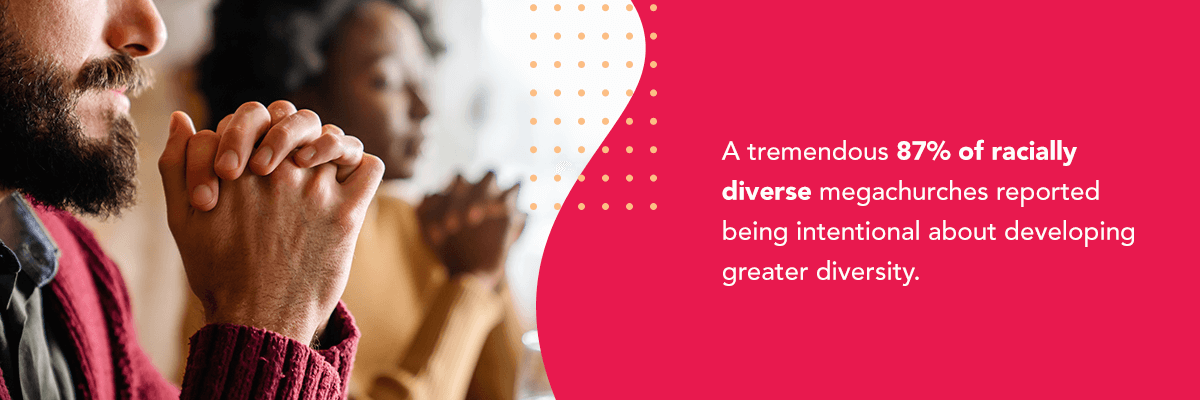
Megachurches have grown in other areas of diversity, too. Leaders who emphasized creating a racially diverse congregation also emphasized ethnic and socio-economic diversity. These churches had a higher rate of new members, immigrants and members with special needs. Megachurches are increasingly varied in the education levels, ages and political persuasions of their members.
Megachurches are likely to continue in this direction as they share their message across racial boundaries.
4. Smaller Sanctuary Size
Despite rising attendance numbers, the average megachurch seating capacity remains the same. The Hartford study found that the capacity of the largest megachurch sanctuary space — where primary services are held — stayed around a mean of 1,200.
Overall, megachurches reported a mean of 5,982 regular participants in worship services and religious activities. This figure indicates most megachurch buildings can only seat a fraction of their regular participants at one time. This ratio contrasts that of most single-site churches, whose median seating capacity was 1,375, exceeding actual attendance.
Why do megachurches have such small seating capacities? Researchers theorize that the steady seating capacity is due to megachurches’ use of multiple sites and worship times, enabling believers to attend their preferred service and spread out the number of people in attendance at any given time. Megachurch leaders often add more worship times or start a satellite church rather than build a larger corporate worship space.
It is unlikely many megachurches will reverse this seating capacity trend. With the popularity of offering multiple worship services, including those streamed online, leaders will most likely keep current seating capacities and encourage members to participate at different times and in different ways.
5. Increased Online Services
Before the COVID-19 pandemic, livestreaming worship services was a relatively uncommon practice among most churches in the United States. A study conducted by Lifeway Research in the fall of 2019 found that 41% of pastors said their church didn’t post any part of the worship service online. In addition, 47% of Protestant churchgoers in America reported never watching a worship service online instead of attending in person.
Before pandemic lockdowns began in March 2020, a majority were already livestreaming services. The pandemic has dramatically impacted many statistics on livestreaming. Another Lifeway study found 97% of churches offered digital worship services in April 2020, and nearly half of all Americans had watched an online Christian worship service during the pandemic, including some who had never attended an in-person service.
Most churches will likely continue offering online services, yet they also want to engage online watchers in new ways. Activities like online giving and interactive virtual services will probably continue as congregations adapt to new expectations.

6. Greater Number of Services Offered
As megachurches grow, they face the logistical issue of accommodating more attendees. Sometimes the solution is to build a larger building or spread out to another site through a church plant or satellite congregation. Megachurches often offer church services at different times at the same location to give members multiple options for attending worship.
The number of separate worship services a megachurch offers its members has increased to an average of 7.6 services per week. In 2000, that number was only 4.3 per week. Interestingly, single-site megachurches average 3.3 services per week, whereas multisite churches average 2.4 services per location.
The extra work of organizing, staffing and running multiple worship services can be a barrier to this kind of shift. Yet many churches find that with the right leadership, multiplying services can multiply attendance. Leaders can get members involved by advertising it as a new opportunity for service. Hosting multiple services at one location allow attendance to increase when the building’s seating capacity would otherwise limit it.
Multiple worship services can give churches a chance to serve members’ needs better. With different worship times, members can choose to worship at a time that best fits their schedules. The convenience and growth accompanying additional worship times make it a trend megachurches will probably hold onto.
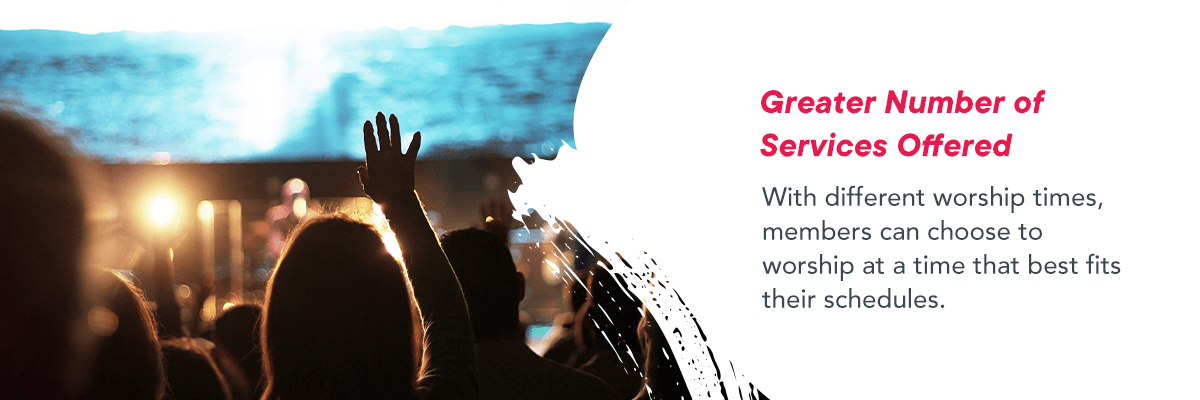
7. Greater Involvement in Community Service
Another area of growth megachurches have experienced is an increase in community involvement. When the researchers for the Hartford study asked megachurch respondents if they considered themselves actively involved in their local communities, 89% agreed. This trend reveals megachurches are more engaged in activities together outside of the church building than in the past.
Community service extends beyond a single congregation and into partnerships with other Christian groups and faith traditions. In one question in the Hartford study, megachurches were asked whether their involvement with other organizations of these types has increased or decreased. Across the board, megachurches reported greater involvement with other groups. Over 50% of megachurches engaged in community service activities with other Christian groups, up from 46% in 2015. In addition, 21% of respondents participated in community service with groups of another faith.
As other trends like small groups continue growing, community involvement likely will too. Since congregations serving their communities also emphasize sharing their faith with those outside their church, these churches are undoubtedly on a growth trajectory.
8. More Adoption of Smaller Churches
Church planting and satellite congregations are a couple of ways megachurches spread and engage with other believers in their communities. Many megachurches are also merging with or adopting smaller or midsize congregations. Church leaders decide to merge with smaller congregations for several reasons, including the opportunity to pool resources and volunteers to reach those outside their community.
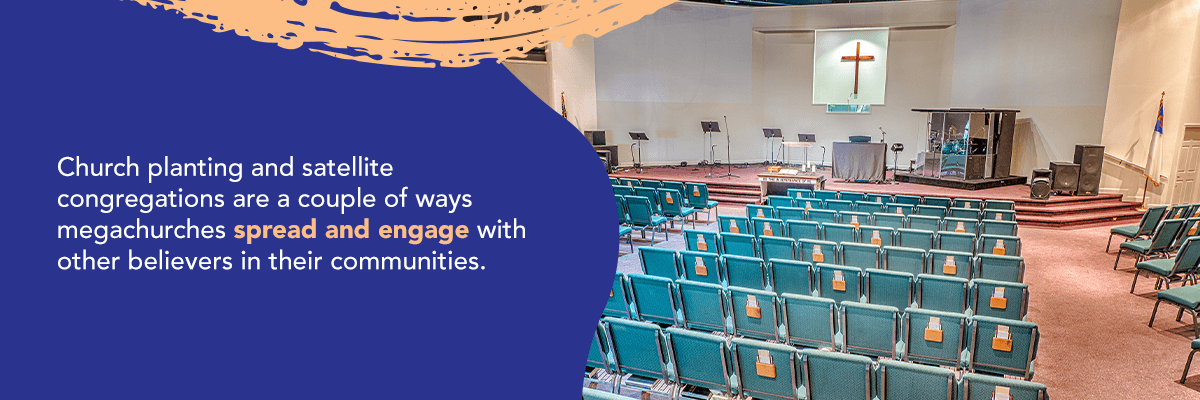
Sometimes a smaller church reaches out for a merger to benefit from the larger congregation’s leadership and vision. At other times, congregations might merge to achieve more racial diversity or some other goal. Whatever the reason, church mergers are definitely trending upward. Of the megachurches surveyed in the Hartford study, 16% were part of a merger between 2016 and 2020. That figure is up from the 6% who merged with another church between 2010 and 2015.
Another factor that could impact megachurch mergers is the lead pastor’s tenure. The longer a pastor is at a church, the less likely that church is to merge or open new sites. As small churches experience the same decline in attendance that churches across the nation are seeing, they might increasingly seek partnerships with larger congregations.
9. Less Political Action
A handful of megachurches have garnered national media coverage for their role in political elections in recent years. However, as a whole, studies show megachurches avoid engaging in politics, whether in worship services or outside — primarily because they are very politically diverse.
Researchers asked megachurches whether they participated in a list of activities focused on increasing awareness for a political candidate or cause. These activities included encouraging members to vote, discussing politics, organizing a march and lobbying for an elected official, among others. Of all the megachurches surveyed, less than 20% said they had done any of those activities in the last 12 months. Only four of the 582 surveyed reported engaging in all six listed activities.
This lack of political action may be ascribed to most megachurches’ political diversity. When researchers asked if the congregation avoided discussing politics when it gathered, 63% said yes. On the other hand, 66% disagreed with the statement that most people in their church held the same political convictions. Possibly because of this avoidance of political topics, megachurches often report little conflict over political issues within their congregations.
In today’s politically diverse climate, megachurches are likely to remain uninvolved in politics, considering the number and diversity of members. Staying out of political discussions and actions could be one way for such large faith communities to maintain unity.
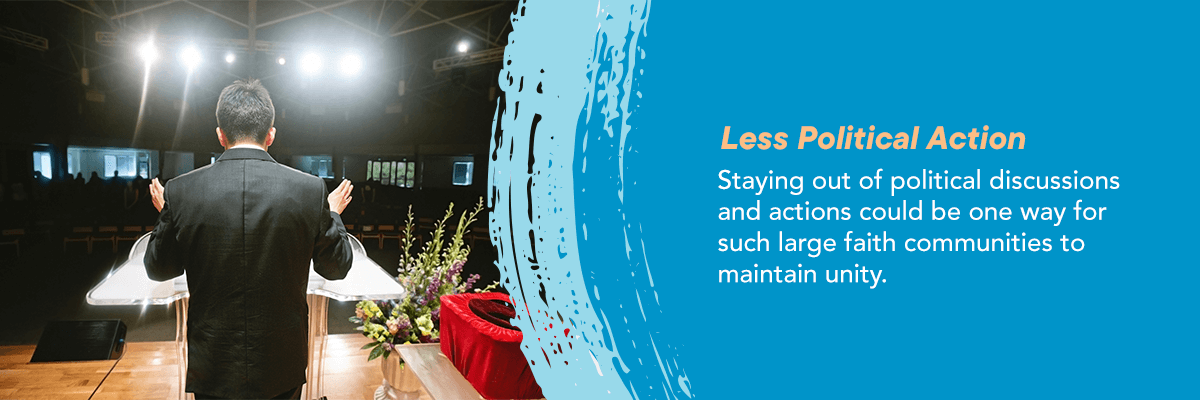
10. Increased Funds
Most churches are funded primarily or entirely by member donations. An average of 96% of a megachurch’s income comes from attendee giving, not other sources.
If you see a rise in attendance at your megachurch, you might conclude it will lead to an increase in funds. However, researchers noticed that funds tend to decrease as attendance increases. As megachurches grew by 10% or more within five years, per capita giving decreased in proportion. The highest giving was at stagnant megachurches, with declining churches close behind.
Reasons for this trend include:
- Attendees at a quickly-growing megachurch may feel less pressure to support the church financially.
- A megachurch’s appearance of success might make members feel that the church doesn’t need their contribution.
- Rapid growth brings in new people who aren’t as committed upfront about giving to the church.
- New members are often young single adults and families with less giving ability.
Megachurch leaders should not be too disheartened by this trend. Research also found the higher the members’ engagement with and trust in the church, the more they gave. For example, when members had a higher rate of attendance at services, personal scripture study, engagement in small groups, talking about their faith with those outside of the church and living that faith in every aspect of their lives, the higher their average annual giving.
The greater an attendee’s trust in church leadership, the more they were willing to give. The Hartford researchers used two factors to measure trust — whether an independent board ran the church and if it received an annual CPA audit. Megachurches run by an independent board had an average of 70% of members who gave more than $1,500 a year.
Combined, greater trust and engagement can clearly help drive a church’s funds. If megachurches can boost their trustworthiness and help attendees grow spiritually to become more committed to their purpose and mission, they could likely see a significant increase in funds.
11. Continued Importance of Lead Pastors
As so many megachurches become multisite and incorporate new leaders and pastors, trends still indicate that the primary church’s lead pastor plays a significant role in church growth. Headline-grabbing scandals have given a few megachurch pastors a poor reputation, yet this is not the reality for most megachurch pastors. Most pastors serve their church for a long time and eventually finish well.
The Hartford study found 73% of current lead pastors were in charge during the church’s most significant growth period. This indicates churches stick with the leader who saw them through their biggest expansion, even when that expansion is several years in the past. A church’s greatest growth comes between years five and 19 of the senior pastor, and its spiritual vitality peaks between years 10 and 19. Any significant changes in the church, like a merger or church plant, are less likely to occur beyond the pastor’s 10-year mark.
These figures indicate that age and tenure are important in a pastor’s impact on their congregation. The pastor of a megachurch’s “growth era” has distinct advantages, as later pastors generally face challenges revitalizing the congregation. All pastors can help their church continue into new areas of growth by communicating and living by their vision, seeking new opportunities and guiding their members’ spiritual health.
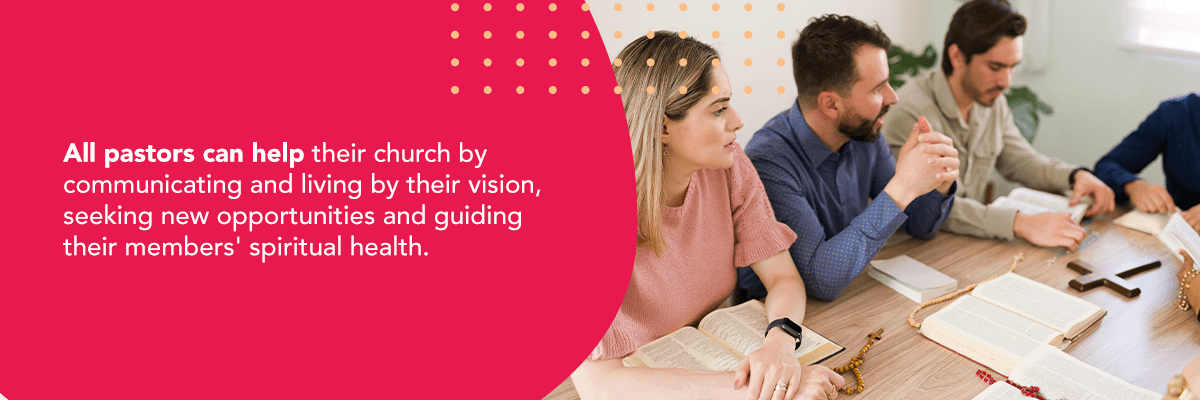
How Megachurches Can Prepare for These Trends
If you are a pastor or part of a megachurch’s leadership or growth team, these megachurch trends for 2022 will likely play a significant role in the decisions you make this year and beyond. Prepare for shifts in attendance, contribution and congregational expectations so you can lead your megachurch into a new year of growth. Consider the following ways to prepare for trends in megachurches:
1. Make a Plan to Engage Online Participants
Before the pandemic, most churchgoers believed that watching an online service was a viable replacement for in-person attendance if you were sick, caring for a sick person or traveling, and not just whenever someone wants. This number has significantly shifted during the pandemic. According to the Barna Group, one-third of practicing Christians reported they have neither streamed their congregation’s online services nor those of another church during the pandemic.
Online services are unlikely to go away any time soon. Megachurch leaders might be concerned about maintaining members and reaching those who have not returned since lockdown. Megachurches can brainstorm ways to engage these potentially lost members and make the online worship experience spiritually rewarding. Some congregations have found a way to make online services more like in-person ones, including the option to host an in-person watch party and virtual small groups and devotionals.
2. Consider Tools for Increasing Attendance
The frequency of worship attendance across all kinds of church assemblies has been declining. In 2020, 68% of the total participants were weekly megachurch attendees. This figure was down from a high of 96% in 2005. An increasing number of Americans never attend religious services at all, with the number up to 29% in 2020.
To combat this trend, megachurch leaders will need to find new ways to attract and retain those outside of their faith. Here are a few suggestions for encouraging growth:
- Prioritize small groups as centers of spiritual growth and relationship-builders.
- Consider making changes like adding worship services at different times or online to give attendees more opportunities to worship.
- Examine the benefits and challenges of a church merger or adopting a smaller local congregation.
- Plan new opportunities to help members engage with each other and their community in meaningful ways.
3. Define Your Church’s Purpose
Helping your church define its purpose and mission is essential for encouraging spiritual vitality. Researchers found that churches who reported high spiritual vitality reported several other characteristics that contribute to an overall positive sense of spiritual health, including:
- A well-defined sense of purpose.
- A willingness to change.
- Higher levels of volunteering.
- Greater openness to including newcomers in congregational life.
- Greater congregational involvement in community and global outreach.
As a megachurch leader, it’s crucial to know your goals and your people so you can direct changes to help members thrive. Keeping the church focused on its purpose can help individual members grow in their spiritual lives and increase your church’s impact on the world.
How Soft Play, LLC Can Help Your Megachurch Grow
Attracting and retaining families is an essential part of megachurch growth. One way to do that is by providing activities and programs for kids that are both educational and fun so parents can enjoy their own small groups or service activities while their kids learn about your church’s message.
At Soft Play®, we provide play equipment for megachurches to attract and retain families. Offering a captivating indoor play area in your megachurch lets parents engage with other members and helps kids learn and play in a caring environment. Our play equipment can be custom-designed to bring your faith to the forefront, so you create more opportunities to share the stories of your scripture.
If your megachurch is looking for ways to make families feel welcome and create a positive environment for kids, Soft Play is here to help. You can tailor play equipment to fit nearly any space and budget. Contact us today to request a quote and learn more about our indoor playground solutions.

